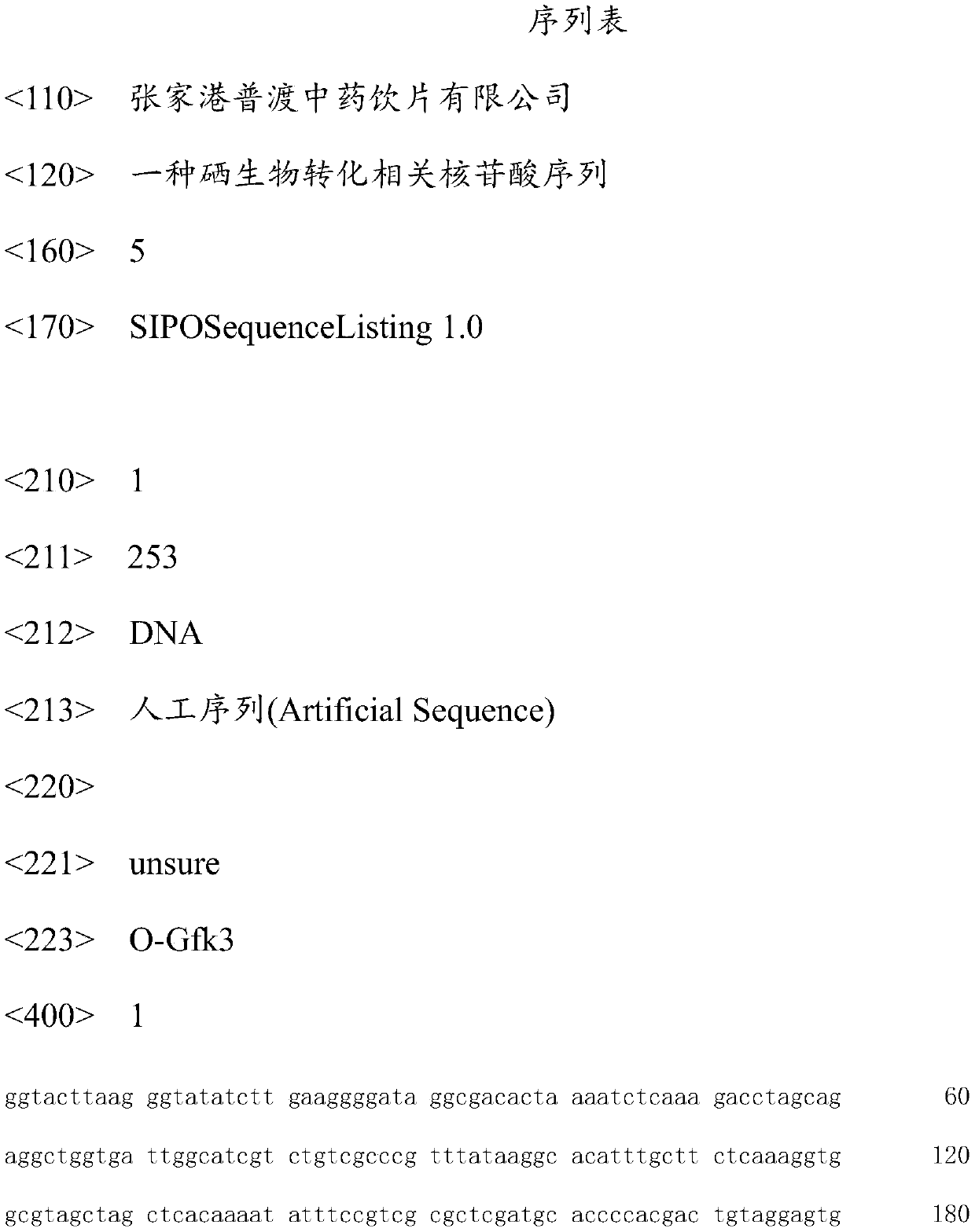Selenium bioconversion relevant nucleotide sequence and application
A nucleotide sequence and biotransformation technology, applied in the field of nucleotide sequences related to selenium biotransformation, can solve the problems of low utilization rate of selenium element biotransformation, selenium flowing into farmland, and high cost, so as to improve human immunity and avoid pollution. Soil, the effect of reducing planting costs
- Summary
- Abstract
- Description
- Claims
- Application Information
AI Technical Summary
Problems solved by technology
Method used
Image
Examples
Embodiment 1
[0021] Take stratified sampling (two layers) and five-point sampling method, in selenium-enriched area (Guizhou Liuzhi Changtian village) in the soil sampling of general planting depth, sampling depth is 6cm and 12cm, every point sampling 100g, totally sampling 1000g, mixing Uniform detection.
[0022] Take 50g of the above-mentioned mixed sample and 100mL of buffer solution and mix them into a dialysis bag, dialyze for 12 hours to remove the salt ions in the sample, use the freeze-thaw method to lyse the cells and extract the total microbial DNA, purify the DNA sample, sequence the purified DNA and use the large intestine The bacillus expression system (E.coli DH5a) constructs the microbial gene library in the selenium-rich soil, and randomly breaks the DNA of the successfully constructed gene library into fragments of 100bp, 150bp, 200bp, 250bp, 500bp, 1000bp, 1500bp, and 2500bp.
[0023] For small fragments of DNA, connect the small fragments of DNA (100bp, 150bp, 200bp, 25...
Embodiment 2
[0026] Carry out codon modification to the Gfk3 nucleotide sequence, Gfk7 nucleotide sequence, and Gfk8 nucleotide sequence to adapt to the plant coding system, and obtain the modified nucleotide sequence O-Gfk3 (as shown in SEQ ID NO.1) , O-Gfk7 (as shown in SEQ ID NO.2), O-Gfk8 (as shown in SEQ ID NO.3). Sequence synthesis entrusted Nanjing GenScript Company to connect the synthesized O-Gfk3 nucleotide sequence, O-Gfk7 nucleotide sequence, and O-Gfk8 nucleotide sequence into the cloning vector pGEM-T, and the operation steps followed the pGEM product of Promega Company -T vector instructions are carried out.
[0027] Recombinant cloning vector Gzg-1103, recombinant cloning vector Gzg-1107, and recombinant cloning vector Gzg-1108 were obtained respectively. The structure of the recombinant cloning vector Gzg-1103 is ampicillin resistance gene, origin of replication of phage f1, LacZ initiation codon, SP6 RNA polymerase promoter, T7 RNA polymerase promoter, O-Gfk3 nucleotide ...
Embodiment 3
[0032] According to the method for constructing recombinant cloning vectors Gzg-1103, Gzg-1107, and Gzg-1108 described above, the recombinant cloning vectors Gzg-1103, Gzg-1107, and Gzg-1108 and the expression vector pCAMBIA1200 were digested with restriction endonucleases NcoI and HindIII, respectively. , insert the excised O-Gfk3, O-Gfk7, and O-Gfk8 nucleotide sequence fragments into the restriction sites of the corresponding expression vectors, and use conventional restriction methods to construct vectors is well known to those skilled in the art , constructed into recombinant expression vector Gzg-110003 (kanamycin gene; right border; promoter (SEQ ID NO:4); O-Gfk3 nucleotide sequence (SEQ ID NO:1); terminator (SEQ ID NO :5); LB: left border); Gzg-110007 (kanamycin gene; right border; promoter (SEQ ID NO:4); O-Gfk7 nucleotide sequence (SEQ ID NO:2); terminator (SEQ ID NO:5); LB: left border); Gzg-110008 (kanamycin gene; right border; promoter (SEQ ID NO:4); O-Gfk8 nucleoti...
PUM
 Login to View More
Login to View More Abstract
Description
Claims
Application Information
 Login to View More
Login to View More - Generate Ideas
- Intellectual Property
- Life Sciences
- Materials
- Tech Scout
- Unparalleled Data Quality
- Higher Quality Content
- 60% Fewer Hallucinations
Browse by: Latest US Patents, China's latest patents, Technical Efficacy Thesaurus, Application Domain, Technology Topic, Popular Technical Reports.
© 2025 PatSnap. All rights reserved.Legal|Privacy policy|Modern Slavery Act Transparency Statement|Sitemap|About US| Contact US: help@patsnap.com



